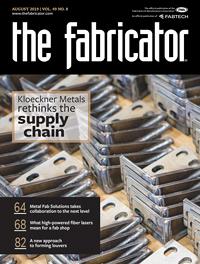Senior Editor
- FMA
- The Fabricator
- FABTECH
- Canadian Metalworking
Categories
- Additive Manufacturing
- Aluminum Welding
- Arc Welding
- Assembly and Joining
- Automation and Robotics
- Bending and Forming
- Consumables
- Cutting and Weld Prep
- Electric Vehicles
- En Español
- Finishing
- Hydroforming
- Laser Cutting
- Laser Welding
- Machining
- Manufacturing Software
- Materials Handling
- Metals/Materials
- Oxyfuel Cutting
- Plasma Cutting
- Power Tools
- Punching and Other Holemaking
- Roll Forming
- Safety
- Sawing
- Shearing
- Shop Management
- Testing and Measuring
- Tube and Pipe Fabrication
- Tube and Pipe Production
- Waterjet Cutting
Industry Directory
Webcasts
Podcasts
FAB 40
Advertise
Subscribe
Account Login
Search
Streamline the metal fabrication's global supply chain
It’s a goal shared by fabricators around the world
- By Tim Heston
- August 9, 2019
- Article
- Shop Management

Companies around the world are rethinking the metal fabrication supply chain to find new ways to compete. Getty Images
In April 2018 a team of enterprising individuals decided to try a new business model for the fabrication business. At first they thought they would simply play matchmaker. Their thinking went that the typical fab shop didn’t have strong marketing platforms. Fab shops are everywhere, after all, but no one knows they’re there.
But eventually those enterprising individuals found they had to do more than matchmaking. They had to delve into project management. Clients send them drawings; they find fab shops with the right capabilities and available capacity; they purchase the material; and they handle the quality assurance. Far beyond simple matchmaking, they’re now offering a turnkey package.
Thing is, these individuals don’t live in the United States. Srinath Ramakrishnan and Amrit Acharya live in India. Their company is called Zetwerk, and the launch could be a harbinger of the kind of supply chain developments the industry might experience over the coming decades.
“We have built a network of more than 500 of the best fabrication shops throughout India,” said Sidhdharth Shah, Zetwerk’s head of exports. “And we have onboarding teams who are continually looking out for new suppliers.”
The company offers what it calls a “manufacturing platform,” and as Shah’s job title implies, Zetwerk is looking to compete across India and, ultimately, on a global scale, including North America. “We’re also looking for U.S.-based fabricators to collaborate with us to expand their interest.” Some U.S. fabricators partner with plants in Mexico, and Shah said he sees a similar potential between Zetwerk and U.S. fabricators.
After a stint in the U.S., one of the company’s founders returned to India several years ago looking for a problem that could be solved with a technology platform. The other founder had family in the metal fabrication business.
“We started as a pure matchmaking platform,” Shah explained. “It’s a challenge in India for companies to find the right suppliers. These shops aren’t online. You can’t just Google them. But then we found that matchmaking doesn’t solve all the problems. With large projects, the problem was about execution. So we moved from just being a marketplace to becoming a platform. We no longer do the matchmaking. We do the complete order. The network takes the order from the clients, and all the orders that come through this network are owned by the network. We add our project management and quality control teams that institute these processes across the various workshops in our network.”
When a client seeking fab work submits a request for quote (RFQ) online, Zetwerk engineers study the drawings, then match the RFQ up with about five shops. They’re not selected randomly but instead are matched based on their capabilities, location, and a variety of other attributes. “Our team negotiates with suppliers and selects the best quotation,” Shah said. “It will not necessarily be the lowest price, either. The match is made based on who’s best suited for the job, and the timeline and delivery date they’re able to promise.”
Fabricators new to the program start with a few projects. Those early projects give Zetwerk an idea of their capabilities, and the work ramps up from there. Shah said that about 30 percent of workshops in the network now get 70 percent of their revenue from Zetwerk. “And about 25 fabricators now work exclusively for us,” he said, “because we’ve become a very predictable source of revenue for them. They don’t have to do any marketing; they just have to focus on what they do best and leave the rest to us.”
This business model isn’t entirely new. Stateside, a company called Xometry has developed a network of North American shops that began in machining and 3D printing and now incorporates metal fabrication. OEMs contact Xometry for a job. Xometry returns an instant quote, based on historical data and, thanks to artificial intelligence (AI) technology, is perfected over time. The details behind Xometry and Zetwerk are quite different, but the overall idea is the same: to connect a host of small, hidden job shops with OEMs and other large manufacturers and fabricators looking for more fabrication capacity.
Zetwerk and Xometry are just two examples of a new kind of competitive edge: the streamlined value chain in a world of highly variable demand. In the broadest sense, companies are working together differently to squeeze out waste.
Consider Wisconsin-based The Village Companies. It’s an organization of highly collaborative companies, including Metal Fab Solutions (MFS), a 3-year-old fab shop. The village is all about sharing resources, from engineering to human resources and safety. A company might not need intense engineering work done all the time; it comes in waves. Spreading those waves across a larger network of companies turns them into ripples. Demand becomes more consistent, the value chain more efficient.
In the past 20 years metal fabrication has been transformed by advanced machinery and related software. Two decades ago a laser operator would look agog at a 12- or 15-kW fiber laser cutting a nest at extraordinary speeds. A bending operator might react similarly with the incredibly complicated staged bending setups that software allows and the consistency and accuracy today’s brakes can achieve.
What will we stand agog over 20 years from now? It’s hard to predict, but the industry might have some new, very different players. They could include various networks of shops that stay small but collaborate closely, with data and algorithms driving out waste and better utilizing available capacity. Ultimately, they’ll aim to spread risk, smooth out demand variability, and streamline the value chain—locally and globally.
About the Author

Tim Heston
2135 Point Blvd
Elgin, IL 60123
815-381-1314
Tim Heston, The Fabricator's senior editor, has covered the metal fabrication industry since 1998, starting his career at the American Welding Society's Welding Journal. Since then he has covered the full range of metal fabrication processes, from stamping, bending, and cutting to grinding and polishing. He joined The Fabricator's staff in October 2007.
subscribe now

The Fabricator is North America's leading magazine for the metal forming and fabricating industry. The magazine delivers the news, technical articles, and case histories that enable fabricators to do their jobs more efficiently. The Fabricator has served the industry since 1970.
start your free subscription- Stay connected from anywhere

Easily access valuable industry resources now with full access to the digital edition of The Fabricator.

Easily access valuable industry resources now with full access to the digital edition of The Welder.

Easily access valuable industry resources now with full access to the digital edition of The Tube and Pipe Journal.
- Podcasting
- Podcast:
- The Fabricator Podcast
- Published:
- 04/16/2024
- Running Time:
- 63:29
In this episode of The Fabricator Podcast, Caleb Chamberlain, co-founder and CEO of OSH Cut, discusses his company’s...
- Trending Articles
How to set a press brake backgauge manually

Capturing, recording equipment inspection data for FMEA

Tips for creating sheet metal tubes with perforations

Are two heads better than one in fiber laser cutting?

Hypertherm Associates implements Rapyuta Robotics AMRs in warehouse

- Industry Events
16th Annual Safety Conference
- April 30 - May 1, 2024
- Elgin,
Pipe and Tube Conference
- May 21 - 22, 2024
- Omaha, NE
World-Class Roll Forming Workshop
- June 5 - 6, 2024
- Louisville, KY
Advanced Laser Application Workshop
- June 25 - 27, 2024
- Novi, MI


























